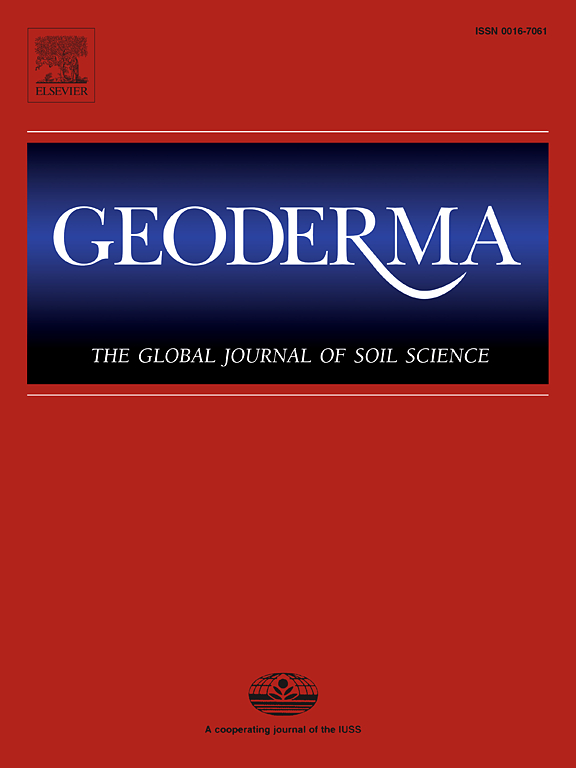生物炭通过铵氧化和铁还原刺激缺氧土壤中的氮流失
IF 6.6
1区 农林科学
Q1 SOIL SCIENCE
引用次数: 0
摘要
厌氧氨氧化与铁还原(Feammox)是缺氧土壤中重要的氮循环途径。生物炭被广泛用作土壤改进剂,据报道,生物炭通过其氧化还原活性部分影响N动力学,但不同热解温度对Feammox的影响尚不清楚。我们采用15n同位素示踪法在水稻土中进行了浆液培养,以研究在300°C和600°C下热解的生物炭在不同铁可用性条件下(添加水合铁、针铁矿或不添加铁)对Feammox的影响。生物炭热解温度和铁可用性影响Feammox的速率。具体来说,在土壤中以2%的质量比添加600°C热解的生物炭,通过Feammox刺激N损失0.03至0.07 μg -1土壤d-1,可能是通过其表面氧化还原活性部分促进电子转移。Feammox与铁还原高度相关,尽管只贡献了总体铁还原的一小部分。Feammox率在添加水合铁时最高,在不添加铁时最低,并且与已知的Feammox细菌(酸化微生物科细菌A6)的丰度相关。相比之下,在300°C下热解的生物炭不会刺激Feammox,可能是由于缺乏电子穿梭能力。总的来说,我们的研究结果强调了高温热解生物炭对促进氮作为二氮损失的刺激作用,强调了其在环境友好型去除缺氧土壤中过量氮的潜在效用。本文章由计算机程序翻译,如有差异,请以英文原文为准。
Biochar stimulates nitrogen loss in anoxic soil through ammonium oxidation coupled with iron reduction
Anaerobic ammonium oxidation coupled with iron (Fe) reduction, known as Feammox, is an important nitrogen (N)-cycling pathway in anoxic soils. Biochar, widely employed as a soil amendment, has been reported to influence N dynamics through its redox-active moieties, but the effects on Feammox of biochar produced with different pyrolysis temperatures remain poorly understood. We conducted a slurry incubation in rice-paddy soil with 15N-isotope tracing to examine the impact of biochar pyrolyzed at 300 °C and 600 °C on Feammox under different Fe availability conditions (addition of ferrihydrite, goethite, or no Fe). Biochar pyrolysis temperature and Fe availability impacted rates of Feammox. Specifically, adding biochar pyrolyzed at 600 °C to soil at a 2 % mass ratio stimulated N loss through Feammox by 0.03 to 0.07 μg N g−1 soil d-1, likely by facilitating electron transfer via its surface redox-active moieties. Feammox was highly correlated with Fe reduction despite contributing only a small fraction to overall Fe reduction. Feammox rates were greatest with ferrihydrite addition and lowest with no Fe addition, and correlated with the abundance of a known Feammox bacterium (Acidimicrobiaceae bacterium A6). In contrast, biochar pyrolyzed at 300 °C did not stimulate Feammox, likely due to a lack of electron shuttling capacity. Overall, our findings highlight a stimulation effect of biochar pyrolyzed at high temperature on promoting N loss as dinitrogen, underscoring its potential utility for environmentally-friendly removal of excess N from anoxic soil.
求助全文
通过发布文献求助,成功后即可免费获取论文全文。
去求助
来源期刊

Geoderma
农林科学-土壤科学
CiteScore
11.80
自引率
6.60%
发文量
597
审稿时长
58 days
期刊介绍:
Geoderma - the global journal of soil science - welcomes authors, readers and soil research from all parts of the world, encourages worldwide soil studies, and embraces all aspects of soil science and its associated pedagogy. The journal particularly welcomes interdisciplinary work focusing on dynamic soil processes and functions across space and time.
 求助内容:
求助内容: 应助结果提醒方式:
应助结果提醒方式:


